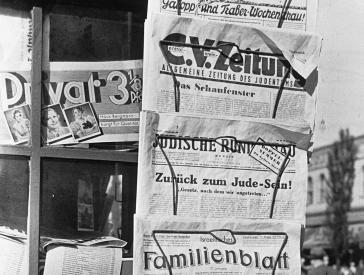"Bedřich Fritta: Drawings from the Theresienstadt Ghetto"
Press Information
Press Release, Wed 15 May 2013
The Jewish Museum Berlin presents the first comprehensive exhibition dedicated to the Czech graphic artist and caricaturist Bedřich Fritta (1906–1944). Between 1942 and 1944, he secretly captured everyday life in the Theresienstadt ghetto in numerous drawings. When this was discovered, Fritta was charged with "atrocity propaganda," and was deported to Auschwitz in October 1944. He died there soon afterwards. Around 100 large ink drawings and sketches survived in hiding. Today they are in the possession of the artist’s son, Thomas Fritta-Haas.
As part of Berlin’s theme year "Diversity Destroyed," the Jewish Museum Berlin is presenting 38 of Fritta’s large ink drawings and many of his sketches.
- Kontakt
-
Press office
T +49 (0)30 259 93 419
presse@jmberlin.de
- Address
Jewish Museum Berlin Foundation
Lindenstraße 9–14
10969 Berlin
Up to now, Bedřich Fritta’s works have been regarded mainly as historical documents. This exhibition, by contrast, focuses on the aesthetic techniques that Fritta deployed to interpret daily ghetto life. It reveals the diversity of his visual language and the extraordinary artistic quality of his work.
Commissions and resistance
Fritta was deported to Theresienstadt in 1941 at the age of 35, along with his wife Johanna and his son Tomáš, then barely a year old. A graphic designer and cartoonist from Prague, Fritta supervised the official drawing studio in the ghetto’s Jewish self-administration. Up to twenty imprisoned artists worked in the studio under SS orders, producing construction plans and propaganda material. They had access to ink and paper, and the "painters of Theresienstadt" used these materials to document the misery of everyday reality in the ghetto—clandestinely, and at the risk of their lives. Many of their artworks survived in safe hiding places. Fritta’s drawings were buried in a tin box in a farmyard shortly before his arrest.
A new perspective on Fritta’s works
As a trained draftsman, graphic designer, and caricaturist, Fritta had a solid grasp of his era’s predominant style. The officially commissioned drawings detail the ghetto’s infrastructure, idealizing its daily routine and masking its actual horror. In his "illegal" drawings, however, Fritta uses different artistic techniques to address the reality around him.
The exhibition (17 May to 29 September 2013) explores the full spectrum of Fritta’s aesthetic expression. In the drawings displayed under the heading "Phantasmagorias," Fritta works with the visual language of the fantastic and the grotesque, reminiscent of Alfred Kubin’s macabre pictorial worlds.
The ink drawings, full of stark contrasts, elicit an Expressionist intensity. Bright highlights collide with the darkness of the ghetto’s sleeping quarters, courtyards, workshops, and streets. Fritta works with artificial lighting effects that were familiar from the movies.
Fritta’s background as a cartoonist is reflected in his pen drawings, with their fine, sharp lines. These works recall the formal language of socially critical Expressionists such as George Grosz or Otto Dix. Fritta uses them to harshly criticize the privileged life of the detainees classified as "prominent persons," and caricatures the ambitious "beautification campaign" mounted by the SS to deceive the international public about the ghetto’s real conditions. The "model settlement" with its cafés and stores becomes a farce, as rickety facades are propped up to hide the piles of corpses.
A picture book for his son Tommy
Bedřich Fritta gave his son Tomáš, known as Tommy, a picture book for his third birthday. In colorful illustrations, it traces Tommy’s daily life in Theresienstadt. But many of the drawings also enter a fantasy world, as father and son set off on imaginary journeys to foreign and exotic lands, or the artist explores different possible careers for the boy. Fritta wanted his little son to be able to imagine a world outside the ghetto. Tomáš was later given the book by his adoptive father Leo Haas, the only one of the "painters of Theresienstadt" to survive their discovery. After the war, he retrieved Fritta’s pictures and Tommy’s book from their hiding place.
Thanks to a special loan for the exhibition, the Jewish Museum Berlin is able to display the original picture book.
Today, Thomas Fritta-Haas lives in the West German town of Mannheim. He says of his father’s picture book: "The only thing that remains to me, that belongs to me, that was made for me alone, is my book, a book by my father. In that book I can feel him, his tears, his hope, his fear."




